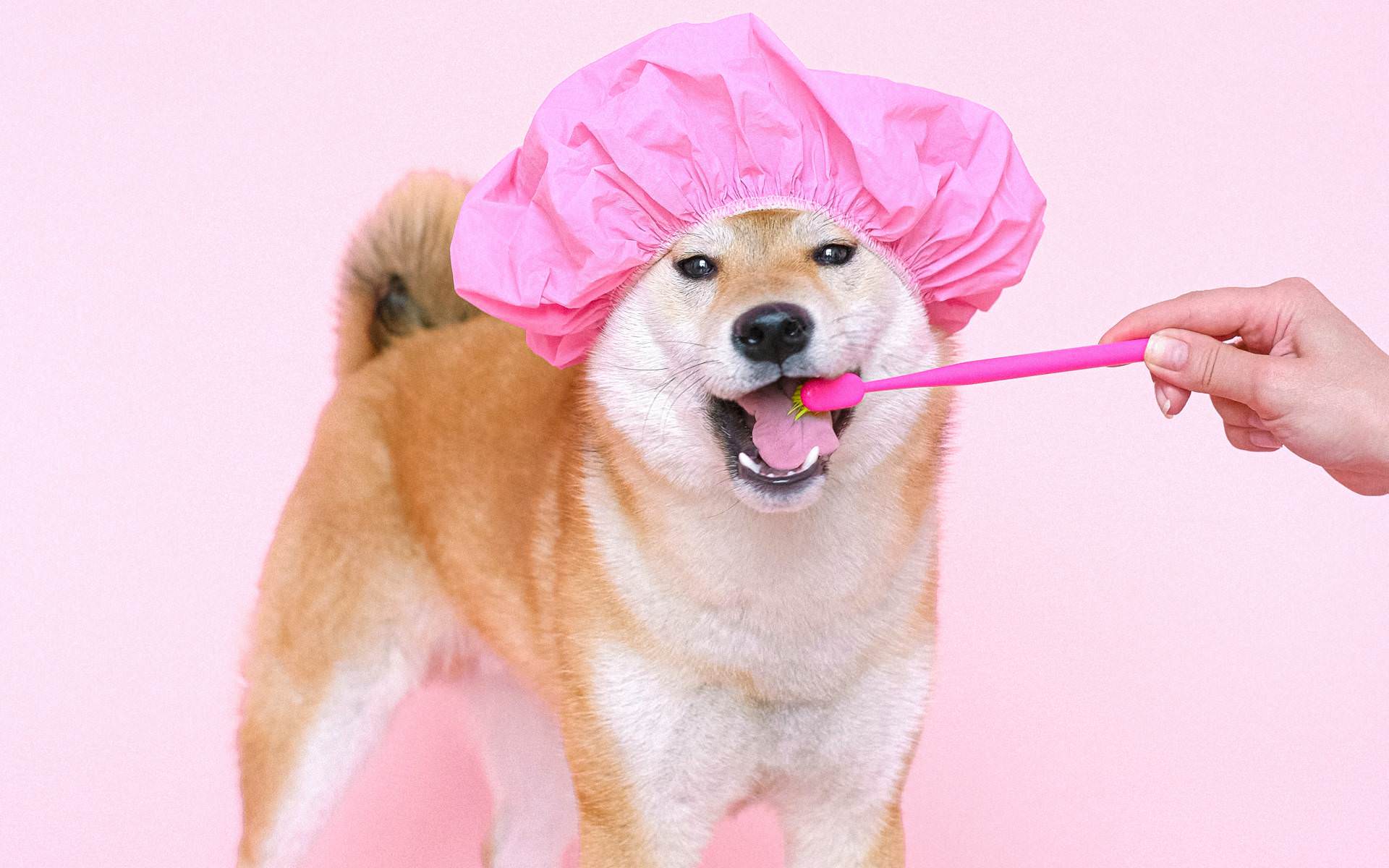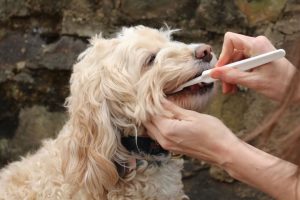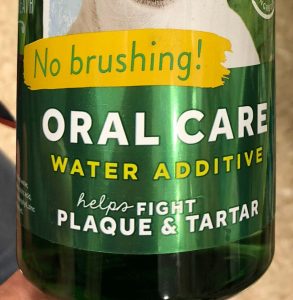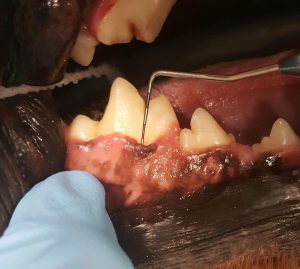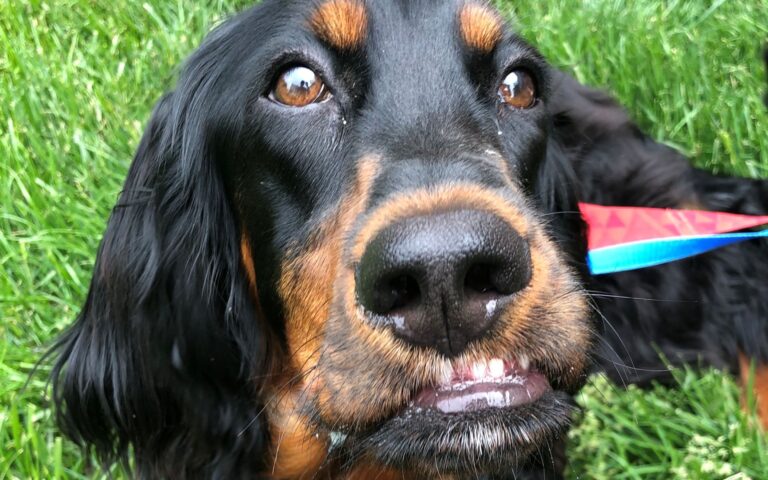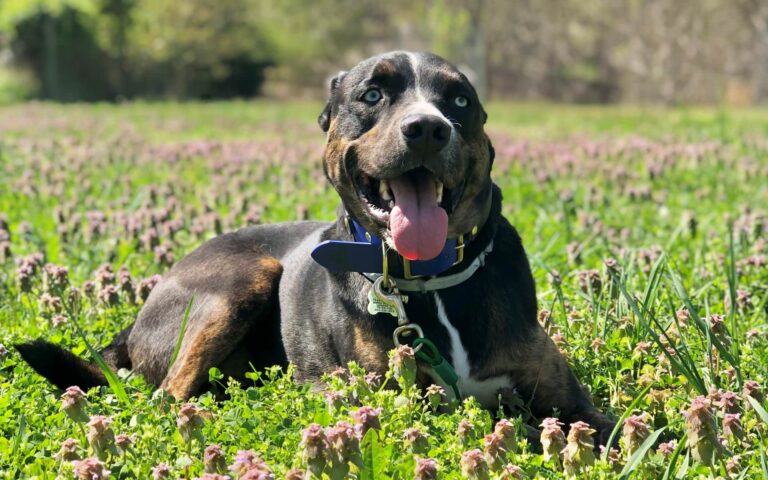Periodontal Disease
Periodontal disease is one of the most common diseases diagnosed in dogs and cats. Simply put, it is a disease caused by the build-up of plaque along the gumline. Plaque is a sticky material that builds up on teeth and contains millions of bacteria that are protected within the plaque biofilm. Plaque causes the first stage of periodontal disease, gingivitis, indicated by swollen and bleeding gums. As periodontal disease advances, it affects the structures that surround the tooth and hold it in place, including the cementum that covers the root of the tooth, the periodontal ligament, and the alveolar bone. The result of untreated periodontal disease is discomfort, pain, and bone destruction, which causes eventual tooth loss.
Additionally, chronic inflammation caused by bacteria in the mouth can significantly impact overall health and longevity. Periodontal disease has been scientifically shown to be associated with diabetes, kidney disease, liver disease, heart disease, lung disease, etc… in both humans and animals. A healthy mouth = a healthy body!!!
Are there risk factors for periodontal disease in dogs and cats?
Any age or breed of animal can be affected by periodontal disease, but there are certain factors that can increase the risk of periodontal disease in dogs and cats. It is important to remember that periodontal disease requires not only the build-up of plaque and calculus, but also a host that is susceptible to inflammation. Below are some reasons a particular animal might be more susceptible to periodontal disease than another.
Genetics–
- Just like in people, some animals are more prone to developing periodontal disease than others. How one individual responds to plaque build-up on the teeth versus another is largely genetically determined. Small/toy breeds, brachycephalic breeds (short-faced) and purebreds (especially cats) are particularly susceptible to developing more severe forms of periodontal disease.
This little 5 lb guy is predisposed to periodontal disease based on his small size.
Crowded teeth–
- Crowded dentition is seen in the smaller and brachycephalic (short-faced) animals. In many toy breeds and brachycephalic breeds, the teeth are too close together or can be rotated in an abnormal position, making them more prone to developing pockets of bacteria around the teeth.
Brachycephalic breeds like the Himalayan pictured above are
predisposed to many health problems, including dental disease.
Diet-
- Diet is not known to play a specific role in the development or prevention of periodontal disease. However, chewing on safe chew toys and dental diets is a good way to mechanically remove plaque from the teeth. Remember that there are no magic chew toys or diets that will prevent periodontal disease alone. Chew toys, diets, and bones should be considered just one component of proper dental care in addition to brushing and professional dental care.
Can periodontal disease be prevented?
The good news is that periodontal disease can be prevented in most animals. Some cats and dogs have such a strong genetic predisposition to developing periodontal disease that even with daily brushing and regular professional dental care, tooth loss will still occur. Fortunately, that is a small subset of animals. For most of our dogs and cats, there is one main point to know about preventing periodontal disease. Plaque must be kept from building up on teeth. Since this is a nearly impossible task to accomplish, professional cleanings are often required in addition to brushing. Below are some important home-care tips:
BRUSHING:
Brushing is the single most effective thing one can do to remove plaque build-up from around the teeth. Daily brushing should be your goal.
- Some dogs and cats (particularly the larger breeds of dogs) have a natural resistance to periodontal disease. For these, brushing every few days is likely adequate. For those that are prone to disease, daily or twice-daily brushing is required.
- Even the most accomplished of tooth brusher’s will miss up to 20% of the plaque on tooth surfaces. For that reason, daily home-care should be used in combination with regular professional care (cleanings under anesthesia) just as is the case for people.
- Toothpaste is not required for animals. Do not use a human toothpaste in your dog or cat as it is not safe to be swallowed. Dog and cat toothpaste often has a good taste that will make toothbrushing more pleasant for them, but it does not aid in the removal or killing of plaque bacteria, and therefore is not essential. It is the mechanical aspect of brushing that removes plaque from the teeth.
- Any toothbrush can be used. Find one that fits your dog or cat well and is easy for you to handle. There are a variety of options available online and in stores that can be used.
- Take adequate steps to teach your dog or cat to accept toothbrushing (there are many videos online about training your dog to allow brushing, and/or you can follow us @mypetssmile on Instagram for helpful ideas).
WIPES/GAUZE:
- Wipes made for dogs and cats are another good option for the prevention of plaque build-up as they provide much of the benefit of mechanical removal of plaque that brushing does (although brushing is still the most effective means of plaque removal!). For dogs and cats that won’t allow a toothbrush in the mouth, wipes are the next best option. Wiping the teeth with a rough gauze square works great as well.
CHEWING ACTIVITY:
- Chew toys and other oral devices can be considered a supplement to brushing, but it is important to understand that they should not replace proper brushing. There are a number of chew toys, bones and diets designed to help remove plaque. www.vohc.org has a list of dental products that have been tested for safety and efficacy.
- NOTE: We see a large number of dogs that have fractured teeth while chewing on really hard chew bones, particularly nylon bones, marrow bones, antler bones, pressed rawhide, etc… Either avoid these chews altogether or use them with caution. Have your veterinarian check your dog’s teeth for fractures regularly if they are chewing on hard objects.
- NOTE: always monitor your dog when they are chewing! Chew toys and bones can become choking hazards.
SPECIAL NOTE ABOUT ADVERTISING CLAIMS:
- Advertising can be very deceptive! It is important that we be knowledgeable consumers to avoid spending money on products that are useless and potentially harmful. As a general rule, if a product advertises by saying that it will remove tartar with no brushing required, then the product is likely not very useful as there is NO product out there that can accomplish this. As discussed before, plaque is well-protected in a biofilm and requires mechanical disruption to remove. Additionally, once it hardens into calculus/tartar, it is almost impossible to remove without sharp instruments.
This is false advertising! Brushing is required to remove plaque from teeth.
THE IMPORTANCE OF PROFESSIONAL CARE:
- Professional care is a huge component in proper dental care. See your veterinarian or a veterinary dentist regularly to see if a professional cleaning is warranted. Most dogs and cats (especially small breed dogs) will require professional cleanings many times throughout their lives (these might need to occur every 6-12 months depending on the particular dog/cat). How often, and at what age they need their first cleaning, should be determined by your veterinarian or a veterinary dentist. If you notice bad breath, tartar build-up, or gingivitis, it is likely that professional dental care is warranted. Make sure that dental radiographs and an oral examination with dental probing are components of your dog or cat’s dental care.
MY SOAP-BOX:
- Remember that animals DO NOT show signs of dental pain and are often suffering silently from pain or infection in the mouth. It is up to us, as their guardians, to make sure that they are free from any dental disease!
How is periodontal disease diagnosed?
Periodontal disease is diagnosed with a thorough oral examination, dental probing, and radiographs. In our animal patients, anesthesia is required to perform an adequate examination with radiographs. On an oral examination, gingivitis (bleeding on probing), gingival recession, furcation exposure of multi-rooted teeth, mobility of the teeth, and pocketing can all indicate advanced periodontal disease. A periodontal probe is used to measure the depth of a pocket around a tooth, just as is done in people. Probes have markings in millimeters which are used to measure the depth of the gingival sulcus. The sulcus is the space between the gingival tissue and the tooth. If the tissue surrounding the tooth is healthy, the sulcus will be a normal depth (generally less than 1-3 mm in our animal patients). However, if the tissues surrounding the tooth (gingival tissue, periodontal ligament and bone) are unhealthy or have been lost due to advanced disease, the pocket depth will increase according to the amount of tissue loss present. Pocket depth can vary normally between species and sizes of animals. Cats normally have little to no pocket depth (less than 1 mm), and dogs typically have a pocket depth less than 3 mm. However, a 3 mm pocket in a tiny chihuahua might be significant, whereas a 6 mm pocket in a large Labrador can be normal. For that reason, individual variation should be taken into account. Dental radiographs complete the periodontal assessment. Radiographs demonstrate bone loss and tissue destruction around the teeth. Without radiographs, a complete assessment of the dentition is not possible!
Periodontal probing in a dog.
TREATMENT OF PERIODONTAL DISEASE:
Good news! Periodontal disease can be treated! Here’s how:
- The first step in treatment requires dental radiographs, an oral examination, and a professional cleaning under anesthesia.
- If there is advanced disease (attachment loss), periodontal surgery or extractions may be warranted to control the infection or prevent spread of the disease. It is very important to understand that dogs and cats can live in our care without any teeth. It is important to remove diseased teeth for overall health and for quality of life, so if dental extractions are recommended by your veterinary dentist, be assured that they are in the best interest of your dog/cat.
- Periodontal surgery is an option depending on the type of attachment loss and amount of loss. Treatment options can include bone grafting and/or guided tissue regeneration.
Bone grafting:
- This type of surgery is required when periodontal disease has resulted in significant bone loss around a tooth.
- Certain types of bone loss, such as furcational (area between roots) bone loss or horizontal bone loss that involves one or more teeth are not as amenable to periodontal surgery and bone grafting.
- Most bone grafts used in veterinary medicine are called allografts, or bone that is from the same species, but not the same individual. These grafts are freeze-dried and sterilized and are excellent at stimulating bone production in areas where it has been lost.
- Bone grafting is also used often in fracture repair.
- Bone membranes are useful for severe oronasal fistulas as well.
Guided-tissue regeneration (GTR):
- GTR procedures are often done in combination with bone grafting. GTR membranes are made to encourage normal healthy periodontal structures to reattach to the tooth surface and to keep undesirable tissues out while healing takes place.
- There are a variety of membranes available for veterinarians to use.
Whenever advanced periodontal procedures, such as bone grafting and/or guided tissue regeneration, are performed, re-examination under general anesthesia is required 3-6 months after treatment. Daily home-care with brushing and antiseptic rinses is also required.

